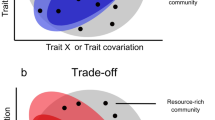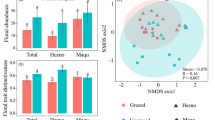Summary
Seed dormancy has been considered, almost without exception, as a bet-hedging strategy in a temporally varying environment. However, in this paper we show that seed dormancy can improve the reproductive success of the mother plant when competition between sibling seedlings and adult plants is intense even if the environment is temporally invariable. We allow a cohort of sibling seeds to germinate simultaneously in the same patch and assume a density dependent survival and fecundity of seedlings. In the model, the mother plant is assumed to control the germination behaviour of the seeds, e.g. by enclosing the seeds in coats of different hardiness. When sib competition is intense, a postponed germination of her seeds can increase the reproductive success of the mother plant up to four times, measured in terms of the number of grandchildren. Consequently, our results suggest that postponed germination may function as a mechanism that alters local interactions in viscous plant populations with limited dispersal.
Similar content being viewed by others
References
Beverton, R. J. H. and Holt, S. J. (1957)On the dynamics of exploited fish populations Vol 19. HMSO, London.
Cheplick, G. P. (1992) Sibling competition in plants.J. Ecol. 80 567–75.
Cohen, D. (1966) Optimizing reproduction in a randomly varying environment.J. Theor. Biol. 12 119–29.
Cohen, D. (1967). Optimizing reproduction in a randomly varying environment, when a correlation may exist between the conditions at the time a choice has to be made and the subsequent outcome.J. Theor. Biol. 16 1–14.
Cohen, D. and Levin, S. A. (1991) Dispersal in patchy environments: the effects of temporal and spatial structure.Theor. Pop. Biol. 39 63–99.
Ellner, S. (1985a) ESS germination strategies in randomly varying environments. I. Logistic type models.Theor. Pop. Biol. 28 50–79
Ellner, S. (1985b) ESS germination strategies in randomly varying environments. II. Reciprocal yield-law models.Theor. Pop. Biol. 28 80–116.
Ellner, S. (1986) Germination dimorphisms and parent—offspring conflict in seed germination.J. Theor. Biol. 51 173–85.
Ellner, S. and Shmida, A. (1981) Why are adaptations for long-range seed dispersal rare in desert plants?Oecologia (Berlin) 51 133–44.
Fenner, M. (1985)Seed Ecology. Chapman & Hall, London.
Giske, J., Aksnes, D. L. and Førland, B. (1993) Variable generation times and Darwinian fitness measures.Evol. Ecol. 7 233–9.
Govindarau, D. R. (1988) Mating systems and opportunity for group selection in plants.Evol. Trends Plants 2 99–106.
Hamilton, W. D. (1964a) The genetical evolution of social behaviour. I.J. Theor. Biol. 7 1–16.
Hamilton, W. D. (1964b) The genetical evolution of social behaviour. II.J. Theor. Biol. 7 17–52.
Hamilton, W.D. and May, R. (1977) Dispersal in stable habitats.Nature 269 578–81.
Kelly, J.K. (1992) Restricted migration and the evolution of altruism.Evolution 46 1492–5.
Lerman, J.C., and Cigliano, E.M. (1971) New carbon-14 evidence for six hundred years oldCanna compacta seed.Nature 232 568–70.
Lewontin, R.C. (1965) Selection for colonizing ability. InThe Genetics of colonizing species (H.G. Baker and G.L. Stebbins, eds), pp. 79–94. Academic Press, New York.
Linhart, Y.B. (1976). Density-dependent germination strategies in colonizing versus non-colonizing plant species.J. Ecol. 64 375–81.
Mayer, A.M. and Poljakoff-Mayber, A. (1975)The Germination of Seeds, 2nd edn. Pergamon, Oxford.
Maynard Smith, J. (1978)The Evolution of Sex. Cambridge University Press, Cambridge.
Palmblad, I.G. (1968) Comparative response of closely related species to reduced competition. I.Senecio sylvaticus andS. viscosus.Can. J. Bot. 46 225–8.
Priestley, D.A. and Posthumus, M.A. (1982) Extreme longevity of lotus seeds from Pulantien.Nature 299 148–9.
Queller, D.C. (1992) Does population viscosity promote kin selection?Trends Evol. Ecol. 7 322–4.
Schmitt, J. and Ehrhardt, D.W. (1987) A test of sib-competition hypothesis for outcrossing advantage in jewelweed (Impatiens capensis).Am. Nat. 126 570–5.
Spira, T.P., and Wagner, L.K. (1983) Viability of seeds up to 221 years old extracted from adobe brick buildings of California and northern Mexico.Am. J. Bot. 70 303–7.
Stearns, S.C. (1976) Life history tactics: a review of the ideas.Q. Rev. Biol. 51 3–47.
Stearns, S.C. (1992)The Evolution of Life Histories. Oxford University Press, Oxford.
Taylor, P.D. (1992) Altruism in viscous populations — an inclusive fitness model.Evol. Ecol. 6 352–6.
Tonsor, S.J. (1989) Relatedness and intraspecific competition inPlantago lanceolata.Am. Nat. 134 897–906.
Venable, D.L. and Lawlor, L. (1980) Delayed germination and dispersal in desert annuals: escape in space and time.Oecologia 46 272–82.
Watkinson, A.R. and Harper, J.L. (1978) The demography of a sand dune annual:Vulpia fasciculata. I. The natural regulation of populations.J. Ecol. 66 15–33.
Westoby, M. and Rice, B. (1982) Evolution of the seed plants and inclusive fitness of plant tissues.Evolution 36 713.
Weiner, J. (1988) The influence of competition on plant reproduction. InPlant reproductive ecology (J.L. Doust and L.L. Doust, eds), pp. 228–45. Oxford University Press, New York.
Willey, R.W. and Heath, S.B. (1969) The quantitative relationships between plant population and crop yield.Adv. Agronom. 21 281–321.
Willson, M.F., Thomas, P.A., Hoppes, W.G., Katusic-Malmborg, P.L., Goldman, D.A. and Bothwell, J.L. (1987) Sibling competition in plants: an experimental study.Am. Nat. 129 304–11.
Wilson, D.S., Pollock, G.B. and Dugatkin, L.A. (1992) Can altruism evolve in a purely viscous population?Evol. Ecol. 6 331–41.
Wilson, J.B. (1987) Group selection in plant populations.Theor. Appl. Genet. 74 493–502.
Yodzis, P. (1989)Introduction to Theoretical Ecology. Harper and Row, New York.
Zammit, C. and Zedler, P.H. (1990) Seed yield, seed size and germination behaviour in the annualPogogyne abramsii.Oecologia 84 24–8.
Author information
Authors and Affiliations
Rights and permissions
About this article
Cite this article
Nilsson, P., Fagerström, T., Tuomi, J. et al. Does seed dormancy benefit the mother plant by reducing sib competition?. Evol Ecol 8, 422–430 (1994). https://doi.org/10.1007/BF01238192
Issue Date:
DOI: https://doi.org/10.1007/BF01238192




